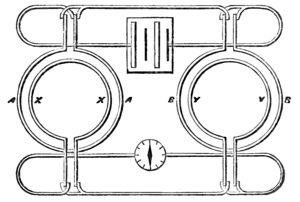on the coil is equal to that of upon , we place the first pair of coils and at a sufficient distance from the second pair

Fig. 32.
and . We then connect and with a voltaic battery, so that we can make the same primary current flow through in the positive direction and then through in the negative direction. We also connect and with a galvanometer, so that the secondary current, if it exists, shall flow in the same direction through and in series.
Then, if the induction of on is equal to that of on , the galvanometer will indicate no induction current when the battery circuit is closed or broken.
The accuracy of this method increases with the strength of the primary current and the sensitiveness of the galvanometer to instantaneous currents, and the experiments are much more easily performed than those relating to electromagnetic attractions, where the conductor itself has to be delicately suspended.
A very instructive series of well devised experiments of this kind is described by Professor Felici of Pisa[1].
I shall only indicate briefly some of the laws which may be proved in this way.
(1) The electromotive force of the induction of one circuit on another is independent of the area of the section of the conductors and of the material of which they are made.
For we can exchange any one of the circuits in the experiment for another of a different section and material, but of the same form, without altering the result.
- ↑ Annales de Chimie, xxxiv. p. 66 (1852), and Nuovo Cimento, ix. p. 345 (1859).




